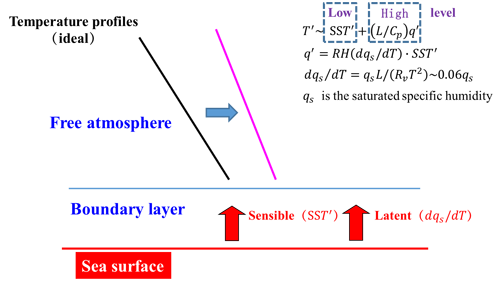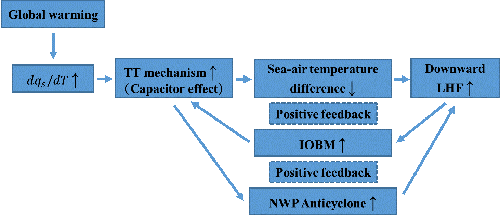
How Will Indian Ocean Basin Mode and Its Capacitor Effect Behave under Global Warming?
Aug 20, 2014 Email"> PrintText Size

For millions of people, the intensity of East Asian summer monsoon indicates the wet or dry conditions there. Plenty of previous studies have proved that the first leading mode of the interannual variability of the Indian Ocean sea surface temperature, also called the Indian Ocean Basin Mode (IOBM), features a basin-wide warming or cooling and that it exerts great influences on the East Asian climate. When the Indian Ocean is warmer than normal, warm tropospheric Kelvin wave is triggered, contributes to the development of an anomalous anticyclone over the Northwestern Pacific via the “capacitor effect” and affect the East Asian summer monsoon. Two recent studies based on CMIP5 revealed the change of the IOBM and its capacitor effect under global warming.
"Our work suggests that the IOBM is slightly intensified, but more obvious enhancement in its ‘capacitor effect’, causing the strengthened anomalous Northwest Pacific anticyclone," said HUANG Gang, a scientist of Institute of Atmospheric Physics (IAP).
HUANG’ team examined the depth of climatological thermocline in the southwestern tropical Indian Ocean and ENSO activity, which are considered to favor the change of the IOBM in observation, and found the two factors cannot explain the strengthened sea surface temperature anomalies under global warming scenarios. Then, what causes the strengthened IOBM and “capacitor effect”? They found that the increased saturated specific humidity plays an important role. Increased saturation specific humidity makes significant contribution to the enhanced tropospheric temperature response (Fig. 1), causing the strengthened “capacitor effect”. Moreover, the enhanced tropospheric temperature provides the positive feedback to the IOBM. The detailed mechanism diagram is shown in Fig. 2.
Their findings, one about the future adjustment of “capacitor effect” and the other about the IOBM, were recently published in Journal of Climate and International Journal of Climatology respectively.
References:
Hu, K., G. Huang*, X. Zheng, S.-P. Xie, X. Qu, Y. Du and L. Liu,2014: Interdecadal variations in ENSO's influences on the Northwest Pacific and East Asia summertime climate simulated in the CMIP5 models, Journal of Climate, 27, 5982–5998. DOI: 10.1175/JCLI-D-13-00268.1
Tao, W., G. Huang*, K. Hu, X. Qu, G. Wen and H. Gong, 2014: Interdecadal modulation of ENSO teleconnections to the Indian Ocean Basin Mode and their relationship under global warming in CMIP5 models, International Journal of Climatology, in press. DOI: 10.1002/joc.3987

Fig 1. The response of tropospheric temperature to the anomalies of sea surface temperature and saturated specific humidity. (Image by IAP)

Fig 2. The diagram about the strengthened IOBM and its capacitor effect under global warming. (Image by IAP)
For millions of people, the intensity of East Asian summer monsoon indicates the wet or dry conditions there. Plenty of previous studies have proved that the first leading mode of the interannual variability of the Indian Ocean sea surface temperature, also called the Indian Ocean Basin Mode (IOBM), features a basin-wide warming or cooling and that it exerts great influences on the East Asian climate. When the Indian Ocean is warmer than normal, warm tropospheric Kelvin wave is triggered, contributes to the development of an anomalous anticyclone over the Northwestern Pacific via the “capacitor effect” and affect the East Asian summer monsoon. Two recent studies based on CMIP5 revealed the change of the IOBM and its capacitor effect under global warming.
"Our work suggests that the IOBM is slightly intensified, but more obvious enhancement in its ‘capacitor effect’, causing the strengthened anomalous Northwest Pacific anticyclone," said HUANG Gang, a scientist of Institute of Atmospheric Physics (IAP).
HUANG’ team examined the depth of climatological thermocline in the southwestern tropical Indian Ocean and ENSO activity, which are considered to favor the change of the IOBM in observation, and found the two factors cannot explain the strengthened sea surface temperature anomalies under global warming scenarios. Then, what causes the strengthened IOBM and “capacitor effect”? They found that the increased saturated specific humidity plays an important role. Increased saturation specific humidity makes significant contribution to the enhanced tropospheric temperature response (Fig. 1), causing the strengthened “capacitor effect”. Moreover, the enhanced tropospheric temperature provides the positive feedback to the IOBM. The detailed mechanism diagram is shown in Fig. 2.
Their findings, one about the future adjustment of “capacitor effect” and the other about the IOBM, were recently published in Journal of Climate and International Journal of Climatology respectively.
References:
Hu, K., G. Huang*, X. Zheng, S.-P. Xie, X. Qu, Y. Du and L. Liu,2014: Interdecadal variations in ENSO's influences on the Northwest Pacific and East Asia summertime climate simulated in the CMIP5 models, Journal of Climate, 27, 5982–5998. DOI: 10.1175/JCLI-D-13-00268.1
Tao, W., G. Huang*, K. Hu, X. Qu, G. Wen and H. Gong, 2014: Interdecadal modulation of ENSO teleconnections to the Indian Ocean Basin Mode and their relationship under global warming in CMIP5 models, International Journal of Climatology, in press. DOI: 10.1002/joc.3987

Fig 1. The response of tropospheric temperature to the anomalies of sea surface temperature and saturated specific humidity. (Image by IAP)

Fig 2. The diagram about the strengthened IOBM and its capacitor effect under global warming. (Image by IAP)
CAS Institutes
There are 124 Institutions directly under the CAS by the end of 2012, with 104 research institutes, five universities & supporting organizations, 12 management organizations that consist of the headquarters and branches, and three other units. Moreover, there are 25 legal entities affiliated and 22 CAS invested holding enterprisesThere are 124 I...>> more
Contact Us

Chinese Academy of Sciences
Add: 52 Sanlihe Rd., Xicheng District, Beijing, China
Postcode: 100864
Tel: 86-10-68597592 (day) 86-10-68597289 (night)
Fax: 86-10-68511095 (day) 86-10-68512458 (night)
E-mail: cas_en@cas.cn

